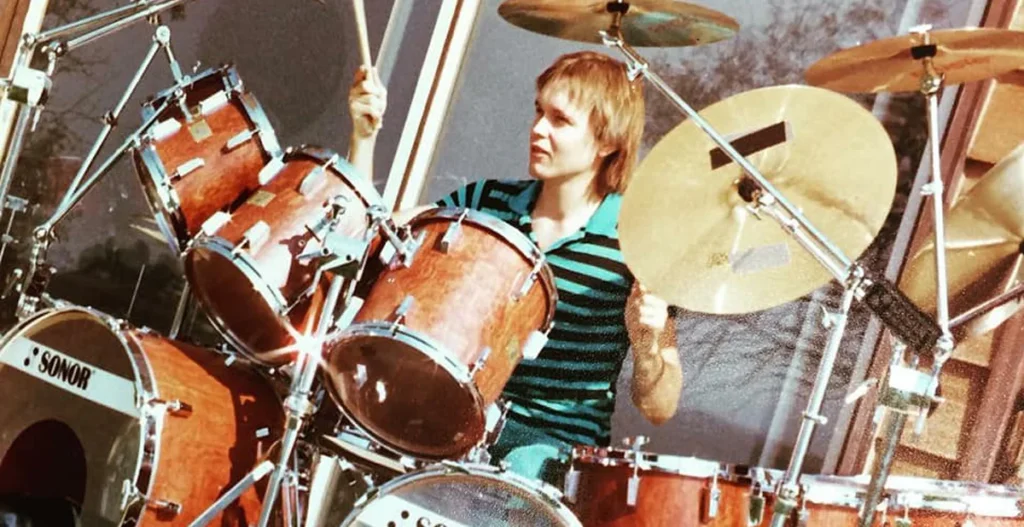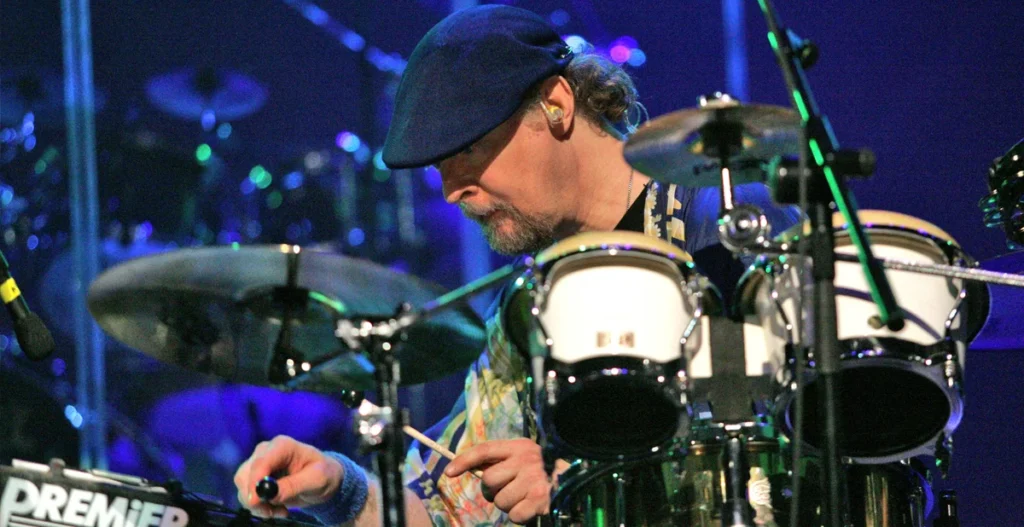The Drummers of Jethro Tull


As a native flutist, I couldn’t help but nab this article. But instead of penning something about the flute in rock music, this time, I will focus on the drummers. Jethro Tull is an English rock band formed in 1967, resulting from two Blusey English groups (John Evan Band and McGregor’s Engine) being smashed together with an added prog rock flair. Despite a break-up in 2012, the group has since reformed and is still touring.
Despite frontman/flutist and vocalist Ian Anderson always being the show’s star, the drummers of Jethro Tull have some serious clout and deserve to be talked about more often! So, without further ado, here are the drummers of Jethro Tull.
Clive Bunker (Drums/ Percussion 1967-1971)
Clive Bunker is from Luton, UK, and was the original drummer of Jethro Tull. He is best known for his quick-paced, detailed playing. He recorded with the band up until the wildfire album, Aqualung. One exciting aspect of Clive Bunker’s playing is that he preferred a hodgepodge “mix and match” drumset rather than a set made by one brand.
Bunker’s style can be described as old-school, jazzy, and intricate. Clive Bunker’s style was primarily formed from his influence of big bands and watching other modern English players like Ginger Baker. Clive Bunker’s flam accents, pitch bending, and other percussive ornamentations are impeccable.
Clive Bunkers’ departure left many people asking questions. Namely, “Why in the world would the drummer exit at the height of the group’s career?!” Bunker left to spend to get married and spend more time with his family. But according to the band’s official site, the drummer also left due to stylistic differences.
In an interview with Forbes Magazine, Bunker stated that he had met a woman on tour and didn’t want to wait any longer.
“Jim Clash: You quit Jethro Tull at what many say was the pinnacle of its success, right after Aqualung. Why?
Clive Bunker: That probably was because we were at the height of it! I couldn’t see us getting any bigger. I’d also met this lady in England. The band was about to start another U.S. tour and then a world tour. After that, we would have moved to Switzerland for a year. So that’s three years away from England! I thought, ‘Ugh. That will be three years before I see her again, so I might as well leave now and get married,’ which is what I did.”
Bunker later joined the Underground English band Blodwyn Pig, including departed member/guitarist Mick Abrahams. To get a feel for Bunker’s sound, check out this solo from 1970.
Barriemore Barlow (1971-1980)
Barriemore Barlow soon replaced Clive in performances. Barlow is from Birmingham, UK, and was a friend of Ian Andersons and John Glascocks when they were in school. “Barriemore” is a quirky stage name—Barlow was originally just “Barrie” at birth.

Barriemore’s style can best be described as punky, persistent, and all-out. His playing was shockingly fast, and his drum set was full of cymbals of all sizes and timbres.
One comical-yet-dark anecdote from when Barlow was with Jethro Tull is that on the night of his second performance ever, some overzealous police officers tear-gassed the audience.
The police also tried to arrest the band. So Barlow and the rest of the group ran and hid and (luckily!) didn’t get caught. Afterward, Barlow asked Ian Andersen if it was like this often. Anderson said, “Only on Tuesdays and Thursdays.”
Barlow played on the album Life’s A Love Song, Bursting Out Loud, and toured with the band. He is well known for his drum track “Thick as a Brick,” which is insanely difficult to replicate because of its technicality and red-hot tempo.
It is unclear why the drummer left, but we know he departed shortly after the album Stormwatch, during bassist John Glascock’s death. Another theory is that Barlow left the group after hearing that the frontman was to create a solo album that a record company would place under the band’s name, Jethro Tull.
Since then, Barlow had commented that his playing back in the day was “over the top” and “busy” and that his style had changed significantly after his time in the band.
According to the band’s website, Barriemore Barlow appeared in a performance with Jethro Tull again in 2008. As he grew as a musician, he became more involved with producing and managing. Barlow built a recording studio called The Doghouse on his land and found he preferred to focus on managing, recording, and spending time with his family rather than performing.
Unfortunately, there are only a few videos of Barriemore Barlow playing. But you can listen to Barriemore Barlow’s virtuosic drumming in the 40-minute (record-breaking) track Thick as a Brick here.
Mark Craney (1980-1982)
Mark Craney was born in Minneapolis, Minnesota, and was raised in South Dakota. His dad played the drums, which sparked his interest in the instrument. But, unfortunately, his time with Jethro Tull was short and sweet.

Craney was a right-handed drummer who played on a left-handed drum kit and was primarily self-taught. Rumor has it that he had wanted to take lessons when he was in his teens but only found a teacher who disapproved of his choice of a left-handed drumset.
He moved to LA in his twenties, where he made many connections. This is how Tull’s subsequent drummer, Doane Perry, and Craney came to know each other. Both drummers had reportedly auditioned for Jean-Luc Ponty (a virtuosic French violinist) in LA. Ponty liked Craney’s audition better than Perry’s, so Perry decided that he had to see Craney live.
Craney died in 2005 at 53 due to an underlying health condition and pneumonia. As a musician, he also played for the singer Gino Vannelli.
Doane Perry (1984-2011)
Doane Perry is from Mount Kisco, New York. Perry is a highly humble musician, once stating in an article he wrote for Modern Drummer, “Ian’s singing and songwriting, of course, has always been the heart and soul of the band.”

Perry once said that his chances of getting girls to chase him down the street (because he played the drums) were relatively low but were worth a shot. Perry has a great sense of humor and is a highly versatile and talented percussionist. His playing can be described as clean, multi-textural, and innovative. Perry has always had his hands on multiple genres and projects. He has worked on everything from film scores to jazz, pop, and even R&B.
His discography with other artists is a mile long and includes albums and tracks with everyone from Lou Reed to Tommy Emmanuel. His broad background leant exceptionally well to the band, which is very multi-genre. Doane Perry recorded with Jethro Tull for Aqualung Live, The Best Acoustic Jethro Tull, The Very Best of Jethro Tull, Through the Years, and more.
Doane Perry is also a composer and author. He currently lives in Los Angeles, California. One interesting fact about Perry and his wife is that they own a home in Bali, where they occasionally visit.
This analysis video by Drumset Artisty will give you a good feel for Perry’s influential style.
Current Drummer: Scott Hammond (2012-Now)
Scott Hammond was born in Bristol, UK. His first instrument was the piano; he didn’t begin learning the drums until he was a teenager. Hammond’s background is primarily based in jazz; he received a 3-year degree in jazz performance from Leeds College. Hammond has also been influenced by rock.

Scott Hammond was a fan of Jethro Tull before he became their drummer. In one interview with David Lopez, he stated that “Minstrel in the Gallery” is his favorite. In the same interview, Hammond said that he most aims to imitate Berriemore’s playing when he’s on stage.
Hammond has both recorded with and toured with Jethro Tull. In addition, he tours with Jingu Bang, The Hopkins-Hammond Trio, and other bands—you can read more about Scott on his website and hear his version of the “Thick as a Brick” solo here.
Side Note: On Jethro Tull’s Disbanding
In 2011, Ian Anderson decided to split up the group. This decision was met with criticism, though. Former guitarist Martin Barre said to LouderSound was ‘speechless.’ As a result, the band was inactive for a few years and went from Perry to Hammond.
Guest Drummers
Jethro Tull also had several guest drummers on stage, including Phil Collins, Gerry Conway, Paul Burgess, Dave Mattacks, Mark Mondesir, and more. In particular, Gerry Conway helped fill the gap between Craney and Perry.
Who is your favorite Jethro Tull drummer, and why? Let me know in the comments!




So there’s a gap between Mark Craney ending in 1982 & Doane Perry who started in 1984. Trying to figure out who the drummer was in 1982? You haven’t mention Gerry Conway? https://en.wikipedia.org/wiki/Gerry_Conway_(musician)
Aquabreath: https://www.youtube.com/watch?v=OFhdIk5clYw Who is the drummer?
I don’t understand why you mention Mark Craney with any more significance than Gerry Conway? They both recorded a complete single studio Album, Craney (A) and Conway (The Broadsword & the Beast). In fact, Gerry Conway also played drums on about 50% of the tracks on Crest of A Knave in 1987. Gerry Conway also did the entire European Broadsword and the Beast tour; therefore, to me he is as much a drummer in Jethro Tull as Mark Craney, if not more. Also Paul Burgess played drums on the North American tour in 1982.
Two other things: 1) Your notations about what recordings the drummers of Jethro Tull a they played on is confusing way off. First of all, Barrie Barlow didn’t play on an album called Life’s A Long Song because Jethro Tull doesn’t have an album of that name! Additionally, Bursting Out is not Called Bursting out Loud! Barlow did however, play on every studio album from 1972 (Thick as Brick) through 1979 (Stormwatch). There were 8 albums recorded during that period in addition to to TAAB and Stormwatch there was A Passion Play (1973), War Child (1974), Minstrel in the Gallery (1975), Too Old Too Rock ‘N’ Roll: Too Young To Die! (1976), Songs From the Wood (1977) & Heavy Horses (1978…and all of them are possibly the most amazing albums in the bands history! Certainly the most complex and enriched recording work was done in the 70’s during this time in the bands history.
Doane Perry also played on: Crest of Knave (1987), Rock Island (1989), Catfish Rising (1991) and what I consider “the last Jethro Tull” studio album, J-Tull Dotcom (1999). Doane, I believe also played on the 2003 Tull Christmas Album.
Scott Hammond, Really? Scott Hammond should never be listed as a Jethro Tull drummer because nothing after 2012 that Ian Anderson recorded is actually a Jethro Tull album in my opinion, for reasons I won’t get into here! Scott Hammond should never be listed as a Tull drummer before the likes of Clive Bunker, Barrie Barlow, Mark Craney, Gerry Conway & Doane Perry (the longest standing drummer in Jethro Tull history… 1984-2011)!
LASTLY, HANDS DOWN…BARRIE BARLOW, FAR AND AWAY THE BEST DRUMMER IN JETHRO TULL AND ONE OF THE BEST DRUMMERS OF ALL TIME. The late John Bonham said “Barriemore was the greatest rock drummer England has ever produced”. enough said!
Tull drummers rank in this order: (1)Barriemore then followed closely by (2)Doane Perry & (3) Mark (4) Clive & Gerry tied. Clive and Doane are two of the nicest guys in Tull I have ever met! Really all the drummer were all amazing in their own way, except for Scott Hammond, who shouldn’t even be discussed here.